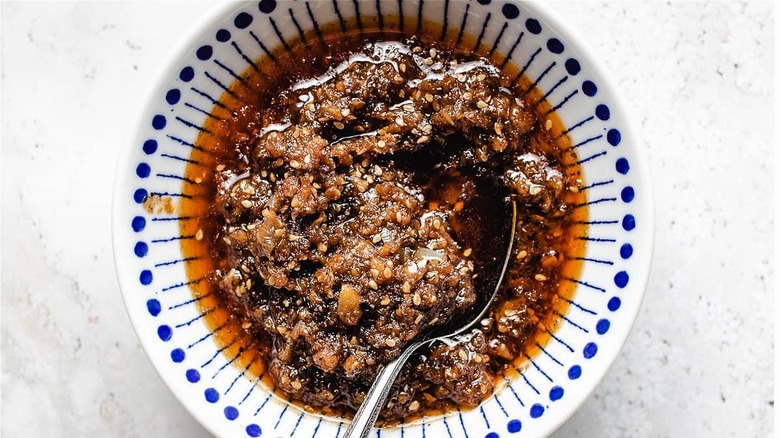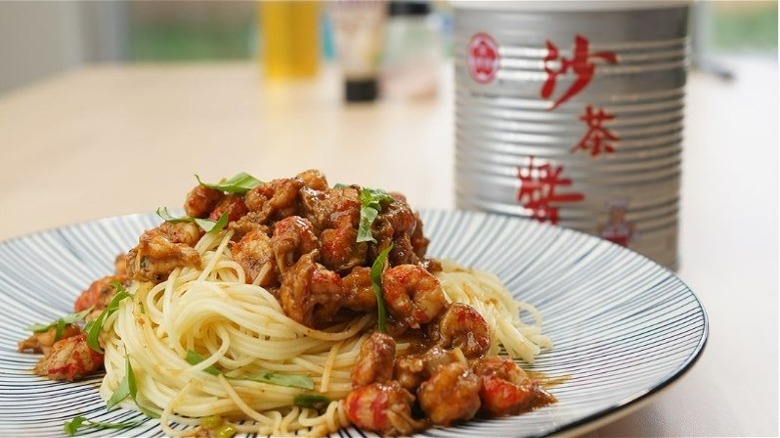China's Sacha Sauce Is The Ultimate Umami-Packed Ingredient
When we talk about barbecue sauce in the U.S., the first thing that likely comes to mind is a summertime cookout with assorted meats drenched in its bold smoky flavors. However, in China or Taiwan, barbecue sauce has a very different taste, swapping out molasses-like richness for full-bodied savoriness. The popular condiment known as sacha sauce (also spelled shacha) or simply referred to as Chinese barbecue sauce, is a must-have fridge staple for those who love Asian cuisine.
Just as we can instantly recognize the iconic green cap and rooster design on a bottle of Huy Fong Sriracha, the same is true for the Bullhead brand of sacha sauce for those who know of it. This silver can with a smiling, apron-wearing bull is loaded up with garlic, chilis, ginger, soybean oil, and shallots, and is usually infused with seafood, such as dried shrimp and flatfish. This is an umami powerhouse of a combination, which adds a big savory kick to a variety of dishes. Sacha is a chunky, oil-based sauce with a hint of sweetness, a hint of seafood, and a lot of spice.
The migratory history of sacha sauce
Sacha sauce is so commonly used in Taiwan that some mistakenly believe this is where the condiment originated, but it's actually a recipe that emerged from China's Chaoshan region. It all began with the creative efforts of migrant workers seeking to upgrade Indonesian satay sauce, a spiced peanut sauce typically paired with grilled meat.
In 1949, Taiwan opened its borders to 1.2 million Chinese immigrants fleeing from the civil war that broke out in China after WWII. This blend of cultures would eventually lead to the creation of sacha sauce, which has since become a hugely popular ingredient in Taiwanese cuisine. Chinese workers discovered Indonesian satay sauce while traveling throughout Southeast Asia looking for better employment opportunities. When they returned to their homeland, they experimented with its flavors and ingredients. The recipe was eventually brought to Taiwan, and the famous Bullhead brand of sacha sauce was created in 1958.
Satay or Thai peanut sauce, a condiment paired with Indonesia's grilled meat dish of the same name, is typically made with a combination of peanuts, garlic, coconut milk, turmeric, and soy sauce, though the spices can vary. Sacha sauce is a much spicier, chunkier, and more complex version of satay sauce, a flavor that is now widely used to infuse a kick into many broth-based dishes throughout Eastern Asia.
How sacha sauce is made
The ingredients found in traditional sacha sauce are an aromatic fusion of savory and spicy. For those looking to make this ultra-umami condiment at home, it can be done in under 30 minutes. For a copycat recipe of the famous Bullhead brand, you'll start by simmering 4 tablespoons of oil on a low heat setting. You can use soybean oil or vegetable oil, and there are many vegetable oil substitutions that would also work, like avocado oil or light olive oil. Start with the chopped shallot, and then add a couple of minced garlic cloves. Add your fresh minced ginger, if you're using it.
Add 2 tablespoons of sea salt and an additional 2 tablespoons of your chosen oil, slowly stirring for another 2-3 minutes as the flavors blend together. Now add dry ingredients like toasted sesame seeds, dried ginger, if you're using, red pepper flakes, and 1½ tablespoons of shrimp powder, a key ingredient if you want to achieve sacha sauce's distinct seafood undertones. After another few minutes on low heat, you have the option to add shredded coconut instead of sugar for a hint of sweetness, and season with black pepper and a kick of chili powder. Three minutes longer on the heat, and your sacha sauce is ready to savor.
What sacha sauce tastes like and how to use it
Sacha sauce is known for its multilayered flavor profile, and it packs more heat than its lighter Indonesian inspiration, satay sauce, while still being a bit sweet. While satay sauce is used primarily as a sauce for meat, sacha sauce stands up to its reputation as a truly multi-purpose kitchen staple.
It's quite the versatile ingredient, commonly added into stir-fries, congee, rice-based dishes, dressings, dips, and as a rub for marinating meat, which is why it's known as Chinese barbecue sauce. Regularly featured as a broth-flavoring hot pot sauce, it's also one of the best ways to elevate basic soups. Drizzle it over rice or a leafy salad, brush it onto meat on the grill, or mix it into noodle-based dishes like stir-fried udon or a piping hot bowl of ramen. The sky's the limit with how you can cook with sacha sauce.
It's important to stir in the top layer of oil when first opening the can. Once opened, it can be stored in the refrigerator for several months until it reaches its expiration date.
Where to buy sacha sauce
The Bullhead brand of sacha sauce, among other varieties, can be easily found at local Asian markets such as H-Mart, Chinese grocery stores, or even purchased online. This popular brand of Chinese BBQ sauce offers other flavor options like vegetarian and spicy Sichuan. However, if you need it in a pinch and would prefer not to make it yourself, Walmart carries this brand, as well as a less-expensive alternative called Lee Kum Kee sacha sauce. You might also be able to find it in the international aisle of larger grocery stores. An expensive equivalent to Chinese BBQ sauce is the luxuriously-named XO sauce, which also has seafood undertones, but is also made with slow-simmered ham.
Perhaps the best option is to make your own. With a small amount of time and a few simple ingredients, you can create a sauce to inspire a multitude of other dishes. And this way, you can make sacha sauce whenever you want while perfecting your recipe, getting the spice levels and mix of flavors just right.




